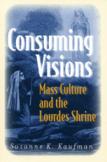Defying Devotional Debasement
One of the most enduring images I have of my visit to the Shrine of Our Lady of Guadalupe in Mexico City in 1999 is the proliferation of religious goods booths, selling every conceivable souvenir or item of devotion, which one must pass in order to reach the shrine itself. I remember being troubled at being subjected to this unabashed consumer spectacle as a forced final step in my religious pilgrimage. I wondered whether, if Jesus were there, he’d be angrily overturning the tables.
This sense many of us have, and perhaps take for granted, that such commercialization somehow debases the religious reality of such holy places is the subject of Suzanne Kaufman’s Consuming Visions. Presenting us with an economic and cultural history of the emergence of the shrine at Lourdes in 19th-century France, she invites us to question our presumptions and seek to “understand how commercialized worship offered rich possibilities for expressing faith and connecting with the sacred in the modern world.” Must the bottling, sale and shipment of Lourdes water, the selling of postcards and, indeed, the selling of the shrine itself in any number of conceivable forms (from devotional items to liquor), be seen as a debasement, or can it be an enhancement of the religious reality? Didn’t such items, Kaufman proposes, allow pilgrims to leave with “a piece of the sacred,” helping them to integrate faith with modern life?
The book serves as an engaging entrée into the ways in which the re-appropriated “traditions” and popular religiosity that the shrine spawned challenged the growing secularism and anti-clericalism of fin-de-siècle France. The media not only became an effective means of promoting the shrine, but also served as a battleground for exploring the many questions that the intersection of faith and culture brought forth. Kaufman shows how the tension between faith and commercialization was a source of tension both within the church and in the larger political arena. But she also shows the savvy that shrine supporters demonstrated in using both public spectacle and various forms of publicity to draw more and more pilgrims to the site.
Kaufman, an associate professor of history at Loyola University Chicago, is especially good at showing how the Lourdes medical bureau, charged with verifying cures, was a particularly inspired and effective means of engaging the modern culture. Under the direction of Gustave Boissarie, M.D., it brought a scientific legitimacy even while debates raged as to the authenticity of reported cures. Kaufman also explores well the complicated role women played in the shrine’s growth. They made up the majority of those cured, prompting questions, based on current psychological opinions, of whether the cures were no more than manifestations of hysteria. As Kaufman sees it, the shrine also made use of them, turning them into religious celebrities who achieved a certain spiritual authority because of the divine grace they had received.
The book finishes with a discussion of the 1943 film “The Song of Bernadette,” noting that “the image of Bernadette had been produced, reproduced, and transformed into a ready-made commodity long before Hollywood producers got their hands on the humble peasant.” True enough, but this leap from turn-of-the-century France to World War II Hollywood also suggests another value of this book. From it we can see the lesson that what appears to be old-fashioned tradition, when brought into the light of modern realities, might be discovered instead to be au courant. Thus, the experience of Lourdes chronicled by Kaufman might hold answers for our own day as we struggle to rediscover our traditions in the light of postmodern realities.
This article also appeared in print, under the headline “Defying Devotional Debasement,” in the August 15, 2005, issue.








